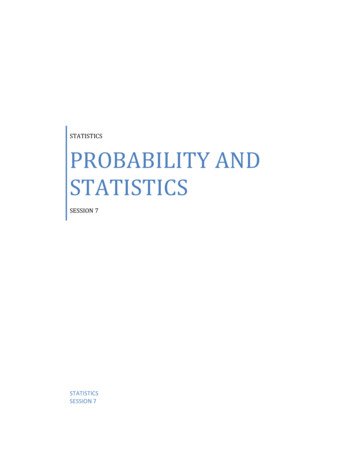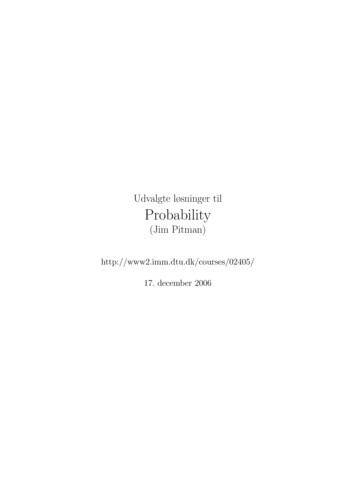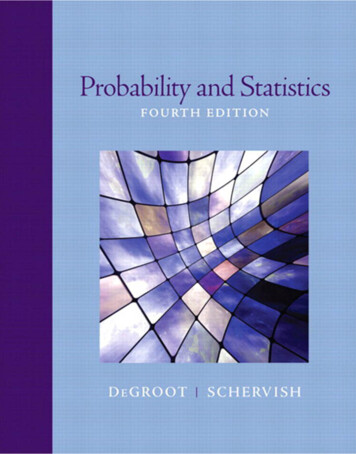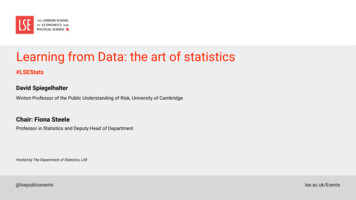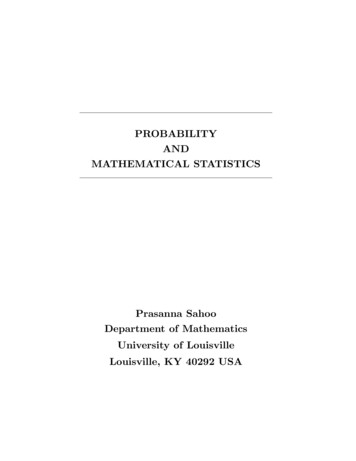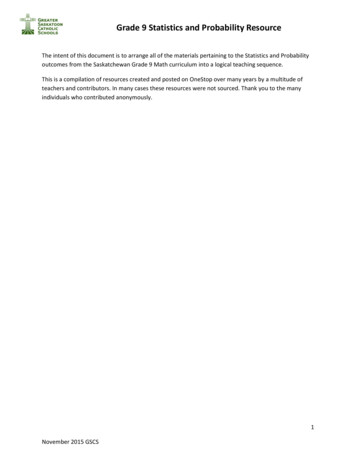
Transcription
Grade 9 Statistics and Probability ResourceThe intent of this document is to arrange all of the materials pertaining to the Statistics and Probabilityoutcomes from the Saskatchewan Grade 9 Math curriculum into a logical teaching sequence.This is a compilation of resources created and posted on OneStop over many years by a multitude ofteachers and contributors. In many cases these resources were not sourced. Thank you to the manyindividuals who contributed anonymously.1November 2015 GSCS
Grade 9 Statistics and Probability ResourceTable of ContentsTable of Contents . 2Teaching Components . 4Assessment . 4Outcome: SP9.1: Demonstrate understanding of the effect of bias, use of language, ethics, cost,time and timing, privacy, cultural sensitivity and population or sample on data collection. 4Outcome: SP9.2: Demonstrate an understanding of the collection, display, and analysis of datathrough a project. . 4Outcome: SP9.3: Demonstrate an understanding of the role of probability in society. . 4Outcome: SP9.4: Research and present how First Nations and Métis peoples, past and present,envision, represent, and make use of probability and statistics. . 4Day by Day Sample Plan . 5Outcome Intro: The Monty Hall Problem . 6Let’s Make a Deal!. 7Games of Chance PowerPoint Presentation . 8First Nations Traditional Games Presentation Topics . 10Indigenous Games Presentation Rubric. 11Math Makes Sense Textbook Notes . 12Unit 9 – Probability and Statistics . 12Unit 9 – Probability and Statistics . 13Unit Objectives:. 139.1 Probability and Society . 13Investigate p. 424 . 13Game: Cube Master p. 430 . 169.2 Potential Problems with Collecting Data . 179.3 Using Samples and Populations to Collect Data . 199.4 Selecting a Sample . 202November 2015 GSCS
Grade 9 Statistics and Probability ResourceTypes of Sampling: . 219.5 Designing a Project Plan . 22Statistics and Probability Assessment (Outcomes SP9.1 and SP9.3) . 23Supplementary Question Bank for SP9.1-SP9.3. 26Gallery Walk: Researching First Nations Use of Statistics and Probability in the Present. 37Day 1 Lesson Plan – Gallery Walk . 37Gallery Walk: Oskayak High Schoo. 55Day 2 Lesson Plan - Discussion. 65Gallery Walk - Individual Reflection . 66Day 3 Lesson Plan - Re-presentation of Data Assignment . 68Instructions for Re-presentation of Data Assignment . 69Rubric for Re-presentation of Data Assignment . 70Sample Assignment #1 and Teacher Assessment . 71Sample Assignment #2 and Teacher Assessment . 72Sample Assignment #3 and Teacher Assessment . 73Data Collection Project . 77Pre-work: Survey Question Proposal Scale – Factors that May Influence Data . 77Data Collection Project (Outcome SP9.2) . 79Census at School . 81Teacher Set-up . 81Census at School Assignment . 82Using Technology to Display Data. 833November 2015 GSCS
Grade 9 Statistics and Probability ResourceMath Makes Sense Resource Teaching Components1.2.3.4.Textbook Sections 9.1-9.4 (SP9.1, SP9.2 and SP9.3)Games of chance presentation and project (“past” SP9.4) (Group Presentation)Data Collection Project (SP9.2) (Individual project)Gallery Walk (SP9.4) (Group activity and discussions) Re-presentation of dataassignment(Individual assignment)AssessmentOutcomeOutcome: SP9.1: Demonstrateunderstanding of the effect ofbias, use of language, ethics,cost, time and timing, privacy,cultural sensitivity andpopulation or sample on datacollection.Outcome: SP9.2: Demonstratean understanding of thecollection, display, andanalysis of data through aproject.Outcome: SP9.3: Demonstratean understanding of the roleof probability in society.Formative AssessmentSummative AssessmentAssignments from textbooksections 9.1-9.4Statistics and ProbabilityAssessment (Outcomes SP9.1and SP9.3)Survey Question Proposal ScaleData Collection ProjectSurvey Question Proposal ScaleDisplay Census at School datausing ExcelAssignments from textbooksections 9.1-9.4Observation during Gallery WalkClass discussion after GalleryWalkOutcome: SP9.4: Research andpresent how First Nations andMétis peoples, past andpresent, envision, represent,and make use of probabilityand statistics.Data Collection ProjectStatistics and ProbabilityAssessment (Outcomes SP9.1and SP9.3)Data Collection ProjectGames of Chance PresentationStudent Reflection of GalleryWalkRe-presentation of dataassignmentObservation during Gallery WalkGames of Chance PresentationClass discussion after GalleryWalkStudent Reflection of GalleryWalkRe-Presentation of DataAssignment4November 2015 GSCS
Grade 9 Statistics and Probability ResourceDay by Day Sample Plan1. Outcome Introduction: The Monty Hall Problem2. Games of chance presentation/ research day (computer lab if possible)3. Textbook section 9.14. Textbook section 9.25. Games of Chance presentations6. Textbook section 9.37. Textbook section 9.48. Textbook Chapter 9 Test (Statistics and Probability Assessment)9. Gallery Walk Day 110. Gallery Walk Day 211. Re-Presentation of data criteria/work time12. Data collection project plan (section 9.5 from textbook) Explain rubrics/requirementsetc.13. Project plan feedback/Working with Excel to display data14. Re-presentation of data assignment due/Class time to work on Data Collection Projecti. Data collection project to be handed in at a later date.5November 2015 GSCS
Grade 9 Statistics and Probability ResourceOutcome Intro: The Monty Hall Problem Background: Monty Hall was the host of the game show Let’s Make a Deal. His classicproblem involved a contestant choosing a mystery prize behind one of three doors.When the contestant picked the door, Monty would open up one of the remainingdoors and then ask the contestant if they wanted to switch. The question: Is there amathematical reason to either switch or stay with the original pick.Video outlining the problem: http://www.youtube.com/watch?v Zr xWfThjJ0 (Justplay up to the point where he describes the problem.)Next steps:o Ask them to predict what should happen.o Determine experimental probability Have students do this in partners with cards (2 black, 1 red). One partnerplays the role of the contestant, one of the host (who knows which cardis the red card). Keep track of whether the contestant switches or staysand what the outcome is (got the red card, didn’t get the red card). Usethe Let’s Make a Deal Handout to keep track.o Combine trials from each group and share this information as a class. Is there anexperimental probability?Play the remainder of the clip to above to show the answer.6November 2015 GSCS
Grade 9 Statistics and Probability ResourceLet’s Make a Deal!Trial NumberChoice (Switch/Stay)Result TOTALSTimes CorrectSwitchedTimes IncorrectTimes CorrectStayedTimes IncorrectPercentage ofSuccessPercentage ofSuccess7November 2015 GSCS
Grade 9 Statistics and Probability ResourceGames of Chance PowerPoint PresentationGo to the SP9.4 Games of Chance Powerpoint Presentation on OneStop. Use teacher notes on bottom ofslides to teach students about First Nations games of chance from the past.8November 2015 GSCS
Grade 9 Statistics and Probability ResourceIndigenous Games Presentations InstructionsYour goal for this assignment is to research and present how First Nations and Metispeoples, past and present, envision, represent, and make use of probability and statistics. Youwill be researching a traditional Indigenous game in groups of two. You will present yourfindings to the class in a short 2-3 minute presentation on Tuesday, March 24. Most of theinformation you will need for your presentation can be fount at the following RR.09.00/treptau1/mathcontent.html Note:information from other websites may be used as well.You should address the following questions in your presentation:1. Who invented the game?2. What tools/materials are needed to play the game?3. How is chance and probability involved? (Or other math concepts)4. What are other variations of the game?5. Why was the game played (strength building, skill development, entertainment,learning, settling disputes, etc.)?You are not required to make a PowerPoint or poster, but any visuals that you believewill help the class understand your game are encouraged.* Tip: try and use relevant mathematical language when relating the game to the coursecontent. This will improve the quality of your presentation.Remember; try to have fun with it. We look forward to your presentations 9November 2015 GSCS
Grade 9 Statistics and Probability ResourceFirst Nations Traditional Games Presentation TopicsGameNamesHubbubBowl and DiceThrow StickStick GameString GamesBall and TriangleStick FlippingAwithlaknannaiKutepuchkunuputuk – StickGuessingPicariaBall and Triangle10November 2015 GSCS
Grade 9 Statistics and Probability ResourceIndigenous Games Presentation Rubric**Please keep this rubric for your presentation day NAMES: 1.2.IEAssignment iseitherincomplete ofdoes not meetthe criteria.DevelopingPresents agame ofchanceunrelated toFirst Nationsand Metisculture.Makesfrequent errorsin explainingthe game orthe mathinvolved in thegame.GrowingPresents agame of chancerelated to FirstNations andMetis culture.ProficientPresents a gameof chancerelated to FirstNations andMetis culture.Explains thegame well, withoccasionalmathematicallanguage.Explains themath involvedusingmathematicallanguage and/orsymbols.Touches on thesignificance ofthe game toFirst Nationsand Metisculture.Explains thesignificance ofthe game toFirst Nations orMetis culture(entertainment,developingskills, strength,etc.).ExceptionalMeets all thecriteria in theproficientcategory.Goes aboveand beyondwith theirresearchand/or visuals.Demonstratesan exceptionalunderstandingof the gameand how thegame relates tomathematics.Comments:11November 2015 GSCS
Grade 9 Statistics and Probability ResourceMath Makes Sense Textbook NotesUnit 9 – Probability and StatisticsUnit Launch p. 422 – 423What does it mean to be an average teenager?Would an average Canadian teenager like the same food as an average Mexican teenager?What are some factors that may influence what is considered “average” among a group ofpeople?How many hours a week do you spend playing sports?What is the probability that a random student in this class spends at least five hours a weekplaying sports?Is this considered experimental or theoretical probability?How do student in this class communicate with their friends?How could you display this data?How do your dislikes, dislikes, opinions and lifestyle compare with those of your friends?How do your dislikes, dislikes, opinions and lifestyle compare with Canadian teenagers?What information might be needed to answer this last question?12November 2015 GSCS
Grade 9 Statistics and Probability ResourceMMS Unit 9 – Probability and StatisticsUnit Objectives: To understand the role of probability in societyTo identify and address problems related to data collectionTo use either a population or sample to answer a questionTo develop and implement a plan to collect, display and analyze data9.1 Probability and SocietyWhy are probability and statistics important?With a partner, brainstorm four examples of when probability is used in real-life:1)2)3)4)Investigate p. 424Probability describes the possibility of an event occurring.Sample Space is the set of all the possible outcomes.An event consists of those outcomes from the sample space that are favorable to the desiredresult.The probability of any event Number of outcomes in the eventNumber of outcomes in the sample space13November 2015 GSCS
Grade 9 Statistics and Probability ResourceProbability can be written as a fraction, decimal, or percent. For example, a 30% probability ofrain could be written as 3/10 or 0.3All probability values lie between zero (likelihood it will never occur) and one (likelihood it willalways occur) inclusive (or between 0% and 100%).Think about the following events. How likely is each to occur? (assign a number between 0 and1 for each event).a)b)c)d)The sun will rise tomorrow.It will snow in the middle of July in Regina.A new student in our class will be a girl.You will pass Math 90.Experimental probability is the probability which results from a given experiment or pastexperience.i.e. The weather forecast says there is a 70% chance of snow.Theoretical probability is the result based upon mathematically deriving it from all the givenequally favorable outcomes.i.e. There is a 5 out of 26 chance that a randomly chosen letter is a vowel.Subjective judgment is the way you may strongly feel despite the given probability. Subjectivejudgments are decisions based on a “hunch” or a feeling.i.e. Buying a lottery ticket because you feel lucky todayWhat are some other examples?Experimental Probability Activities (i.e. flipping a coin, tossing a die)14November 2015 GSCS
Grade 9 Statistics and Probability ResourceTheoretical Probability Examples:1)What is the probability of rolling a six on a six sided die?2)What is the probability of picking a queen out of a normal deck of cards?3)What is the probability of tossing a head on a normal quarter?4)What is the probability of rolling a number greater than 2 on a normal six sided die?Read over examples 1 – 3 on pages 425 – 427Assignment: Pages 427 - 429, # 1 – 11, 17Assessment Focus #11, Reflect (in journal)Math Link p. 429 – discuss in class15November 2015 GSCS
Grade 9 Statistics and Probability ResourceGame: Cube Master p. 430CubeColorsInitialGuessGuess afterGuess after10 cubes20 cubesGuess after 30cubesActual # ofcubes# ofpointsBlueGreenBlack16November 2015 GSCS
Grade 9 Statistics and Probability Resource9.2 Potential Problems with Collecting DataDo “investigate” on Page 431 in groups of 4.Below are several factors that could affect data collection. Please provide your own examplefor each.PotentialProblem:What it means:BiasThe question influences responses in favourof, or against the topic.Use oflanguageThe use of language in a question could leadpeople to a particular answer.TimingWhen the data is collected could lead toparticular results.PrivacyIf the topic of the data collection is personal,a person may not want to participate or maygive an untrue answer. Anonymous surveysmay help.CulturalSensitivityThis means that you are aware of othercultures. You must avoid asking questionsthat may be offense to some cultures.EthicsData collected must not be used for thepurposes other than those communicated tothe participants.CostThe cost of collecting data must be taken intoaccount.TimeThe time needed for collecting the data mustbe considered.Your own example:Going back to “investigate”, identify which potential problems could be related to eachquestion.17November 2015 GSCS
Grade 9 Statistics and Probability ResourceRead the examples on Page 433 - 434Assignment: Pages 435 - 436, # 1 – 16Assessment Focus #13, Reflect (in journal)18November 2015 GSCS
Grade 9 Statistics and Probability Resource9.3 Using Samples and Populations to Collect DataInvestigate p. 43710 fish sample#%20 fish sample#%40 fish sample#%Actual Population#%malefemaleHow did your percents compare with the actual percents? In general, how did your estimateschange as the size of the sample increased?Population – is the group about which you are getting information.Census – is a tool used to collect data from every member of the population. This can be timeconsuming, costly and difficult (if not impossible) to x-eng.cfmSample – is a small portion of the populationValid conclusions – when the sample chosen is representative of the populationRead examples on Page 438 - 440Assignment: Pages 440 – 441, # 1 – 13Assessment Focus #10, Reflect (in journal)Mid-Unit Review: Page 444, # 1 – 9 all19November 2015 GSCS
Grade 9 Statistics and Probability Resource9.4 Selecting a SampleInvestigate p. 445Define each of the following types of sampling in your own words and provide an example (seepage 446):Simple random samplingSystematic/interval samplingCluster samplingSelf-selected samplingConvenience samplingStratified random samplingNow go back to “investigate” and try to classify the different methods of sampling using theterminology above.Read Examples on Page 447Assignment: Pages 447 - 449, #1 - 12Assessment Focus # 8, Reflect (in journal)20November 2015 GSCS
Grade 9 Statistics and Probability ResourceTypes of Sampling:1.Simple random – each member of the population has an equal chance of beingselectedEx.2.Systematic or interval sampling – every nth member is selectedEx.3.Cluster sampling – every member of each randomly chosen group of thepopulation is selected.Ex.4.Self-selected sampling – only members who are interested and volunteer willparticipate.Ex.5.Convenience sampling – only members of the population who are convenientto include are selected.Ex.6.Stratified random sampling – some members from each group of thepopulation are randomly selected.Ex.21November 2015 GSCS
Grade 9 Statistics and Probability Resource9.5 Designing a Project Plan(This may be used as an option when students are assigned the Data Collection Project for OutcomeSP9.2)Investigate p. 454Read through the Connect on p. 454Did your plan from “investigate” contain all these steps?Discuss the example on page 455Day 1 – Project Plan:Go through project evaluation rubric with students (Teachers - see Master 9.3 on p. 53 ofProGuide)Have students read pages 454 - 455 and do Questions # 1 – 10 on page 455 - 456Students Collect DataDay 2 - Unit Problem: Students work through activities and Questions on Page 461.Your project is due on .You must hand-in the following: The project plan from Section 9.5 (Questions 1-10) The display of your data (chart and graph) and your conclusions Answers to the presentation questions on Page 461 Your rubric and self-assessmentUnit Review: Pages 458 – 459, #1 – 16Due:22November 2015 GSCS
Grade 9 Statistics and Probability ResourceStatistics and Probability Assessment (Outcomes SP9.1 & SP9.3)(Source: Math Makes Sense Unit 9 Test)Name:Outcome: SP9.1Demonstrate understanding of the effect of bias, use of language, ethics, cost, timing,privacy, cultural sensitivity, population or sample on data collection.Outcome: SP9.3Demonstrate an understanding of the role of probability in society.1. A die with 6 faces is rolled 10 times. Each time, the die shows an even number.Klaus predicts the next roll will be odd.Joanna predicts the next roll will be even.Nicholas predicts the next roll is equally likely to be even or odd.Which type of probability might each person have made his or her prediction? (Theoretical,experimental or subjective judgement)2. Jenna thinks she is likely to score a goal in tonight’s soccer game since she has scored a goalin 4 of her last 5 games.a) What assumptions is Jenna making?23November 2015 GSCS
Grade 9 Statistics and Probability Resource3. Identify a potential problem with each data collection. Justify your answer.a) Rachel asks: “What costume will you wear for Halloween this year?”b) Jerome asks local dog kennels: “How often do you walk the dogs in your care?”c) A dentist sends a questionnaire to her patients 6 months after their last check-up, askingthem to rate the quality of care they received and reminding them to make an appointmentfor a new check-up.4. Would you use a census or a sample to gather each set of data? Justify your choice.a) To determine whether the strings of a guitar are in tune24November 2015 GSCS
Grade 9 Statistics and Probability Resourceb) To determine citizens’ opinions about the new traffic lawsc) To test the quality of a new recipe for a cookbook5. What sampling method is used in each situation? Will it give valid conclusions? Justify youranswers.a) A radio show invites city residents to call in their opinions about the city’s crime rate.b) To predict which movie will win a People’s Choice Award, Carlos asks his friends whichmovies were their favourites.c) For a week, every 10th customer leaving a restaurant is asked to rate the food and theservice.6. Adriane mails a questionnaire asking, “Do you think there is a litter problem in ourneighbourhood?” to every house on her street. What problems might Ariadne encounter as shecollects data? Describe the effect each problem would have on her results.25November 2015 GSCS
Grade 9 Statistics and Probability ResourceSupplementary Question Bank for ath%20Study%20Guide%20(76%20pages).pdf)1. Describe the effect of: bias use of language ethics cost time and timing privacy cultural sensitivity on the collection of data. QUESTION 1Analyze a given case study of data collection; and identify potential problems related to bias, useof language, ethics, cost, time and timing, privacy or cultural sensitivity.SolutionB (timing)Surveying about a ice rink (typically a winter sport) in the summer.QUESTION 2SolutionB (cultural sensitivity)Individual beliefs is a factor to consider26November 2015 GSCS
Grade 9 Statistics and Probability Resource Provide examples to illustrate how bias, use of language, ethics, cost, time and timing, privacy orcultural sensitivity may influence data.QUESTION 3QUESTION 4QUESTION 5QUESTION 627November 2015 GSCS
Grade 9 Statistics and Probability Resource2. Select and defend the choice of using either a population or a sample of a population to answer aquestion. Identify whether a given situation represents the use of a sample or a population.Simple Random Sampling – this type of sampling involves each member of the population having anequal chance of being selected.Systematic or Interval Sampling – this sampling involves starting randomly and then selecting everynth member from then onwardsCluster Sampling - total population is divided into groups or clusters and every member of therandomly selected group is chosen.Self-selected sampling – this sample only includes only members who are interested and volunteerto be part of a survey.Convenience Sampling – this can be known as grab or opportunity sampling. It involves the samplebeing selected from a population which is close to hand.Stratified Random Sampling – this includes randomly selecting members from each group of thepopulation.QUESTION 1QUESTION 228November 2015 GSCS
Grade 9 Statistics and Probability ResourceStatistics are numbers that describe data (the information that is collected to look at).We use statistics to make information more meaningful in everyday life and to understanddifferent trends (patterns) that we see. For example, Stats Canada uses the informationabout Canadian citizens to see rises and falls in immigration, births, deaths, etc.The information is not meaningful just as raw data (numbers that have not been looked at);it becomes meaningful and useful when it is analyzed.Before we can analyze data though, we need to collect it.Population – a collection of people you will get the information from when collecting dataCensus - is the procedure of obtaining and recording information about the members of agiven population. It is often done door-to-door.Sample – is a subset or small portion of the population from which the data is beingcollected from. The sample should be a good representation the entire population.Valid Conclusion – will result if the data is collected from a representative sample of thepopulationQUESTION 3QUESTION 429November 2015 GSCS
Grade 9 Statistics and Probability ResourceQUESTION 5QUESTION 6QUESTION 7 Provide an example of a situation in which a population may be used to answer aquestion, and justify the choice.QUESTION 1YES30November 2015 GSCS
Grade 9 Statistics and Probability ResourceQUESTION 2YES Provide an example of a question where a limitation precludes the use of apopulation; and describe the limitation, e.g., too costly, not enough time, limitedresources.QUESTION 1Ava wants to determine what kind of pizza her friends on the volleyball team like the most. Which of the surveyingmethods would cost the most?A.Mailing out a questionnaire to all junior high studentsB.Telephoning a sample of 30 junior high studentsC.Asking the employees at a local pizza shop about the kind of pizza that is sold the mostD.Conducting personal interviews with a sample of 30 junior high students during recess Identify and critique a given example in which a generalization from a sample of apopulation may or may not be valid for the population.QUESTION 1QUESTION 231November 2015 GSCS
Grade 9 Statistics and Probability Resource Provide an example to demonstrate the significance of sample size in interpretingdata.QUESTION 1Which of the following samples is the best choice to see how many people see the eye-doctor for regularcheckups?A.25 people at the mallB.25 people who wear glassesC.25 people in the waiting room at the eye-doctorD.25 of your friendsQUESTION 2Outcome SP9.3 Demonstrate an understanding of the role of probability in society. Provide an example from print and electronic media, e.g., newspapers, the Internet, where probability isused.Did you ever wonder how the advertisers for Pepsi or Coke come up with their statistics? 8 out of every10 people choose Pepsi over Coke.Or have you ever wondered how they choose the “top 6 at 6:00” on Country 105 FM?We use statistics to make information more meaningful in everyday life and to understanddifferent trends (patterns) that we see. For example, Stats C
Grade 9 Statistics and Probability Resource 1 November 2015 GSCS . The intent of this document is to arrange all of the materials pertaining to the Statistics and Probability outcomes from the Saskatchewan Grade 9 M

